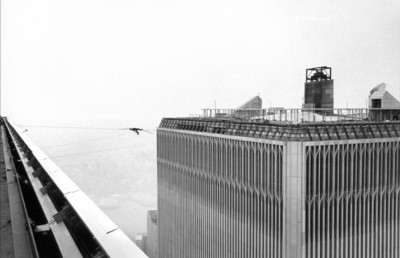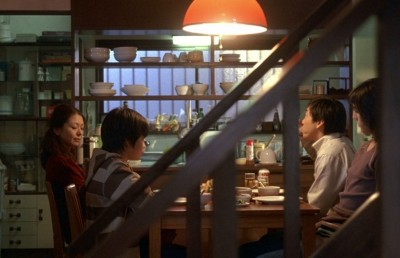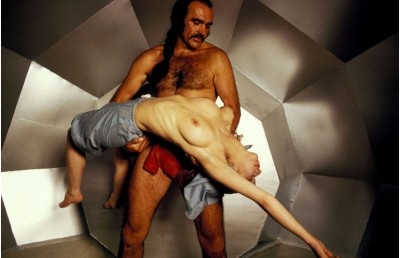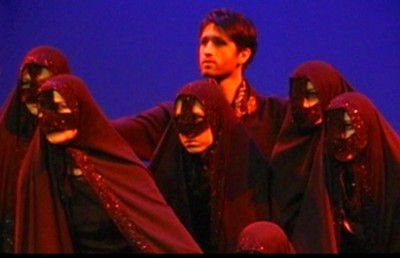Martyrs: Evoking France’s Cinematic and Historical Past
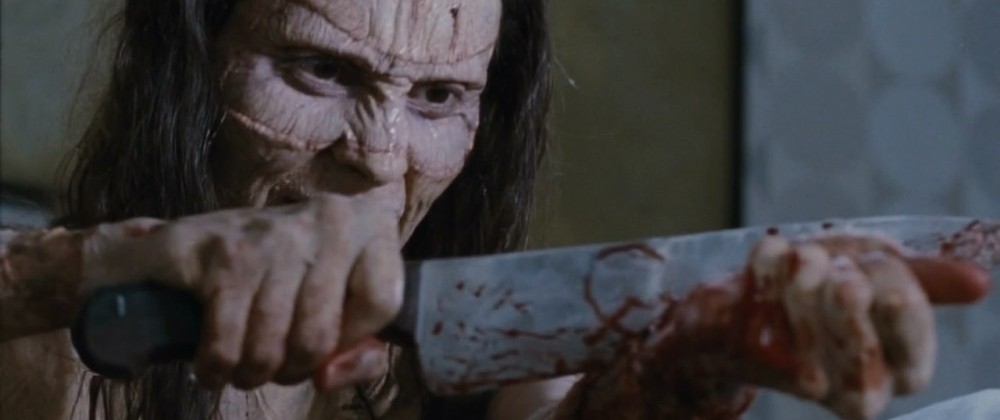
Martyrs (2008, Pascal Laugier) played at the 2008 Festival Nouveau Cinéma (FNC) as part of the Julien Fonfrède helmed Temps Zéro program, which is where you are most likely to find the cutting edge feature films. And Martyrs has a very sharp edge. Martyrs is a controversial horror film which has divided horror fans uncertain what to make of a film which pushes the envelope regarding the use of realistic violence, while using that violence as expression of a genuine philosophical discourse. Martyrs is shocking for the way it changes gears from a home invasion/revenge story, to a grueling, relentless kidnapping/torture story that provides none of the usual pay-off or catharsis common to the torture subgenre (Hostel, Saw). Where Martyrs veers off from the latter is its unique treatment of torture as a means of achieving what the leader of the film’s pseudo religious cult, simply called ‘Mademoiselle,’ describes as ‘transfiguration,’ the moment when the body, through extreme physical suffering, moves beyond awareness of the physical to a state of transcendence where the ‘victim/martyr’ is able to see what is beyond death (“what is on the other side”).
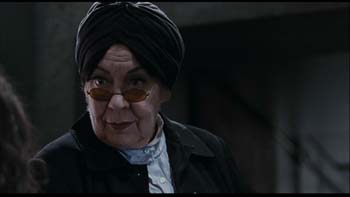
Images of torture have become a mainstay of recent horror films, but few have evoked the historical-military use of torture. When Hostel came out in 2005 and became a box-office success (especially surprising was its success at a mainstream level) many observant critics pointed out that its success could be partially explained by the concurrent media coverage and heightened public awareness of the tortures conducted at the Abu Ghraib prison (most directly the public’s awareness of US implication in these tortures). Since then a documentary by Errol Morris, Standard Operating Procedures (2008) also dealt with the same issue, and featured the disturbing prison torture photographs from Abu Ghraib.
One of the first horror films to have evoked military torture was the great French film by Georges Franju, Les yeux sans visage (1959). In Les yeux sans visage Pierre Brasseur plays Dr. Genéssier, a respected physician who, with the help of a female accomplice Louise (Alida Valli), kidnaps young women and performs horrendous medical experiments on them in an effort to find a successful facial transplant donor for his daughter, Christiane Genéssier (Edith Scob), who had her face disfigured in a car crash. We later learn that Dr. Génessier was driving the car when the accident occurred. I would like to propose an alternate reading of Martyrs that can be seen alongside the philosophical one noted above that compares the film with this earlier masterpiece of French horror, and the context of French post-World War 2 history. Comparing films that are 49 years apart may not seem apparent, but there are many interesting parallels between these two French Fantastic films, which both feature medical horror imagery and gruesome scientific experiments conducted in the service of a twisted “ideal.”
In his essay “History without a Face: Surrealism, Modernity, and the Holocaust in the Cinema of Georges Franju,” Adam Lowenstein places Georges Franju in the context of surrealism, which he sees as an art movement that was decidedly realist when it came to contextualising modernity and revealing the “shocking recognition of history’s horrors within the fabric of the everyday.” [1] The tradition of surrealism was wedded to the documentary in Franju’s prototype direct cinema Le sang des bêtes (Blood of the Beast, 1949), to form a disturbing aesthetic blend where the clinical, objective details of a particular slaughterhouse (its workers, history, method, archival photographs) is married to torrid images of violence, gushing, steaming animal blood, and rows of calf heads lined against a wall, all of which suggest an eerie parallel to what was then recent memory of the Holocaust and German concentration camps. Lowenstein sees Franju’s allegorical horror films as “the agony of awakening –to body, and to history” (27). But to what history? The history “being awakened” in Les yeux sans visage and Blood of the Beast is what French historian Henri Rousso has called the Vichy Syndrome: “A diverse set of symptoms whereby the trauma of the Occupation [1940-1944], and particularly that trauma representing from internal divisions within France, reveals itself in political, social and cultural life” (Lowenstein 27).
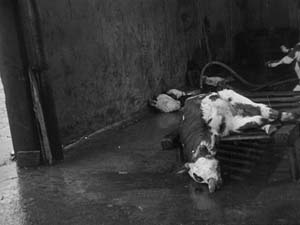
Rousso characterizes the years from 1954-1971 as a time when the myth of ‘resistancialism’ dominated French culture: the myth that all of France identified with the internal French resistance which helped in the liberating of France. He quotes the famous speech by Charles de Gaulle after the Liberation on August 25, 1944, where he claimed, “Paris! Paris humiliated! Paris broken! Paris martyrized! But Paris liberated! Liberated by itself, by its own people with the help of the armies of France, with the support and aid of France as a whole, of fighting France, of the only France, the true France, of eternal France” (quoted in Lowenstein 27). Interestingly, consciously or not, director Pascal Laugier has invoked Charles de Gaulle’s quote with the film’s title (“Paris martyrized”).
This ideology of resistancialism started a “process that sought to minimize the importance of the Vichy regime (July 1940 to August 1944) and its impact on French society, including its most negative aspects (Lowenstein 27). The Vichy Regime, led by Marshal Philippe Pétain, was the French government that ruled after the Third Republic, and called itself the French State. “Vichy France had legal authority in both the northern zone of France, which was occupied by the German Wehrmacht [defense force], and the unoccupied southern “free zone,” where the regime’s administrative centre of Vichy was located” (Wikipedia). The southern zone was under Vichy rule only until the Allies landed in French North Africa, in Nov, 1942. “Pétain and the Vichy regime willfully collaborated with the German occupation to a high degree. The French police and the state Milice (militia) organised raids to capture Jews and others considered “undesirables” by the Germans in both the northern and southern zones….Pétain himself was sentenced to death for treason, but his sentence was commuted to life imprisonment” (Wikipedia).
Franju does not make any easy allegorical links to the World War 2 and the Occupation, but there are more than a few subtle hints at France’s past. In terms of direct historical connection, the film was released during the Algerian War (1954-1962), which ravaged French psyche until the eventual liberation of Algeria in 1962, and for years afterward. A year before the film was released there was a famous autobiographical book by Henri Alleg titled La Question (The Question, 1958) which was a first hand account of the tortures experienced at the hands of the French military in Algeria, which included many violent images that are echoed in the film (Lowenstein 44). Hence audiences of the time would have linked the torture scenes in Les yeux sans visage as much to the Algerian War as to WW2. In this respect, in Martyrs not only are Lucie and Anna lesbians (homosexuals were on the Nazi list of ‘undesirables”) but both are clearly non-white: Lucie being Eurasian and Anna Assaoui being of Arabic descent (the actress who plays the older Anna, Morjana Alaoui, is in fact Moroccan).

However, the most direct (though it is understated) reference to the Vichy regime and French collaboration in Les yeux sans visage comes in an almost throw away line by a young woman who has been admitted into Dr. Génessier’s clinic. As the doctor stands at her bedside looking over her medical chart, the young woman asks him, “Doctor, are you going to shave me?” To which he replies, “I hope not. It would be a shame.” This line is a direct reference to the period during the Liberation where women accused of fraternizing with the Germans were humiliated by being shaved in public, being ‘marked’ for their transgression. There were about 20,000 such people, almost all women, who were punished as Nazi sympathizers. These women are referred to by historians as femmes tondues (‘shorn women’). Many revisionist historical accounts interpret these acts against women as a form of scapegoat for the easy capitulation of France to Germany, the subsequent sense of French male humiliation under the Occupation, and the guilt over France’s collaboration with the Nazis. In short, patriarchal guilt over French collaboration was mapped onto the female body. [2] Perhaps the most famous film, if not the first, to depict a ‘shorn woman’ was Hiroshima mon amour (Alain Resnais, 1959). In flashback we see the lead female character, simply named Elle, played by Emmanuelle Riva, being shaved and humiliated in public for having had an affair with a German lover. [3] The matter of ‘shorn women’ is also quite clearly alluded to in Martyrs, which I will now discuss.
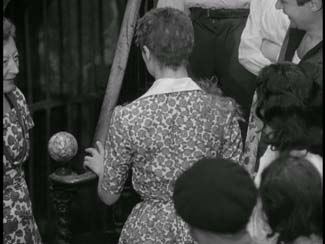
Martyrs opens with a young girl running out of a building, terrified, bloodied, almost nude. The scene cuts to 1971 archival footage of the same building. The camera now assumes the viewpoint of a 16mm, full frame television news crew footage reporting on the abduction and torture of the young girl from the opening shots, who we soon learn is named Lucie (Jessie Pham plays the young Lucie, Mylène Jampanoï plays the older Lucie). A girl, Anna (Erika Scott plays the young Anna, Morjana Alaoui plays the older Anna), is being interviewed about the abducted girl, her friend Lucie. Later that night Lucie and Anna are sleeping together in a pediatric hospital. Lucie lies terrified in her bed, looks up from under her blankets and sees a feral beast at the foot of her bed. The scene cuts to black and flash forwards 15 years. Lucie enters a bourgeois home with a rifle and slaughters a father, mother, daughter and son, stopping only to cryptically tell the terrified son, “You know what your parents did?” From her phone call to Anna informing her that vengeance has been served, we deduce that the man and woman she murdered were the people responsible for her abduction and torture as a child fifteen years earlier. Anna, who cares for Lucie deeply, yet remains ambivalent about the murders, arrives to help Anna dispose of the bodies. Meanwhile Lucie roams the home battling her inner demon, which only she sees in the shape of a nude, feral, bodily scarred female. This ‘monster’ is revealed in flashback to be a torture victim who Lucie could not stop to help as she made her escape from the building. Hence the subconscious creature is a physical manifestation of the guilt that has been haunting her for years —along with other psychological scars of the abduction. (This monster recalls the creature that is a product of the Isabelle Adjani character’s subconscious in Andrzej Zulawski Possession, 1981.)
Although most reviewers of the film take director Laugier’s cue about the film being about ‘suffering’ (and not pain), guilt emerges as perhaps the film’s most important theme. At least it is if we empathize with the two female victims, especially Lucie, whose guilt is so powerful that it produces a ‘monster’. This theme of guilt forms a crucial link to Les yeux sans visage (a father’s guilt over an accident he caused that disfigured his daughter) and France’s National guilt over the Vichy regime and their collaboration with the Nazi.
The power of Lucie’s guilt is rendered in a wonderfully edited scene which alternates between objective and subjective viewpoints. In the ‘subjective’ view we see Lucie being attacked by the feral creature; in the ‘objective’ view Lucie is alone in the frame, performing self-mutilation. Unable to cope with her past, Lucie crashes through a window onto the house grounds and, in the pouring rain, slits her own throat. Anna collects her body and gives it a ritualized burial (cross-like scars on Lucie’s body furthers the theme of martyrdom, as do later shots of the tortured Anna in a Christ-like position).
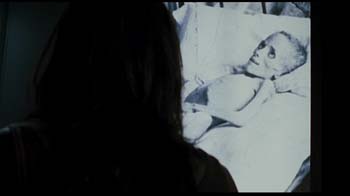
Anna finds a hidden trap door which leads to a modern looking laboratory space. One of the first things she sees are enlarged photographs of tortured women on wall light boxes, forming a perverse hall of fame for martyrs. One of the photos of a body Anna looks at clearly invokes the Nazi concentration camps (fig. 1). Anna unlocks another trapdoor leading her further down into the bowels of the building, where she finds a ‘forgotten prisoner,’ a scarred young woman chained to the wall wearing a steel visor that has been bolted into her skull. Anna rescues the woman and leads her up from her prison pit into the living portion of the house. (The image [fig. 2] of the terrified woman coming out of a underground cell where she has been captive for years, entering a world as if for the first time made me wonder whether Laugier had ever read Plato’s famous Myth of the Cave?)
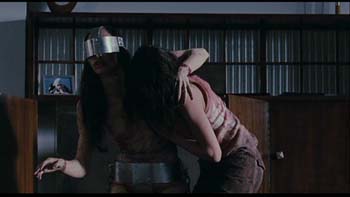
The prisoner resembles the figure that was haunting Lucie, which suggests that Anna was able to fulfill what Lucie could not: rescue a torture victim. And to complete the cycle of violence, Anna will soon replace Lucie as the next victim. Anna’s rescue of the imprisoned girl is short lived, as a group of determined, black dressed adults enter the home like a SWAT team, shoot the prisoner and incarcerate Anna. While Dr. Génessier’s accomplice Louise (Alida Valli) disposes the victim’s corpses into a nearby river, the cult members in Martyrs dispose of the corpses in a mass grave which recalls the mass grave sites of the Nazi concentration camps (fig. 3).
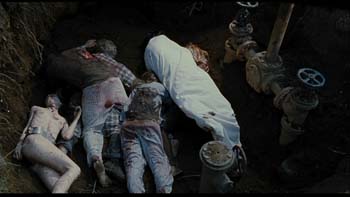
From this point on (65 minute mark) the film takes a radical turn and puts the audience through a grueling 35 minutes of a regimented torturing of Anna. However, unlike the torture represented in films such as Hostel (profit) or Saw (gamesmanship), the goal of the torturing in Martyrs is to bring the victim to a state where she is no longer aware of her physical pain, her physical surroundings, and achieve what Mademoiselle calls ‘transfiguration.’ In the film’s key exposition scene, Mademoiselle explains the philosophy of their violence, which is not to create victims, but martyrs. They methodically inflict pain to make the victim suffer. The sufferer goes through stages where they will begin to see things that do not exist (like Lucie’s guilt monster, or the cockroaches that the other torture victim imagines crawling all over her body). The martyr, on the other hand, gives themselves up to the pain to ‘transcend themselves’ and achieve ‘transfiguration.’
Mademoiselle shows Anna photos of martyrs through history, of women who died having achieved a look of transcendence: a woman from Long Sheng Province in 1912; Jouans-Lussac, 1945, a grocer who slept with a German and was punished for her transgression. Another woman from a Birmingham hospital circa 1960. The 1945 photo of Jouans-Lussac [fig. 4] is a direct reference to the “shorn women” (les “femmes tondues) of post-war France. Shortly into her captivity, Anna has her hair shorn by the woman who tends to her basic needs (food, washing, toiletry).
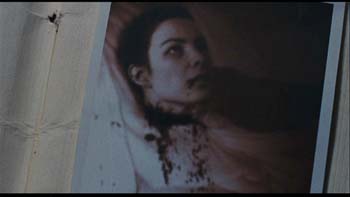
As noted earlier, many feminist and revisionist historical accounts interpret these acts of public humiliation as a form of collective patriarchal scapegoat for the generalized failures of France during World War 2 and France collaboration. Women are also treated as scapegoats in Martyrs, in that women are somehow biologically predisposed to achieving what the torturers are searching for: knowledge of the afterlife. As its leader Mademoiselle says, “women are more responsive to transfiguration…young women.”
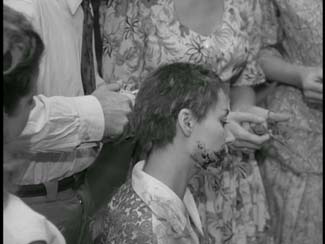
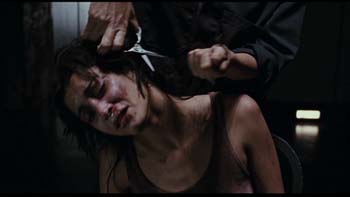
With an intentionally monotonous rhythm, Laugier cuts between scenes of Anna being physical beaten (by a burly man we know nothing about except his name, Michel) to the point of losing consciousness, scenes of her being fed disgusting puree, and scenes of her being washed (these domestic duties are performed by a woman, Michel’s wife we can assume). The sequence attains such a sense of impending doom that each time we hear the trapdoor unlock or see Anna’s space brighten from the incoming light of the open trapdoor, our muscles tighten in fearful anticipation of another beating. After being beaten to a pulp Anna is transferred to a clinical looking room and placed into a circular contraption with a table that tilts on its vertical axis. The image of her strapped into this ridiculous steel mouse trap makes obvious the idea of Anna as a human guinea pig in this cult’s monstrous experiments to quantify (to ‘see’) the spiritual.
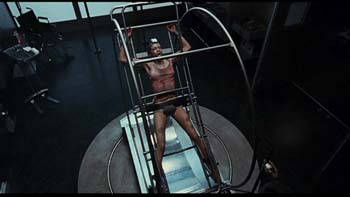
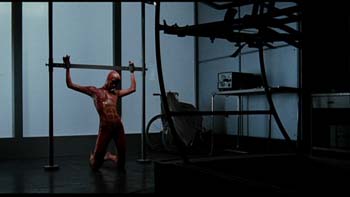
The shaving of Anna’s hair is the first of two physical removals that are part of the ‘stages’ she must endure to be reduced to her ‘essence.’ As the final stage in transfiguration, Michel, now dressed like a doctor, removes every inch of her skin –except for her face– which symbolically reduces her to her ‘essence’: flesh and bone. The removal of all of Anna’s skin except for her face makes an interesting comparison in contrast to Dr. Génessier’s experimental surgery, which does the opposite: removes only the face, while leaving the rest of the body intact (see figs. 5, 6, 7). This forms yet another parallel between Les yeux sans visage and Martyrs: victims that have their skin removed.
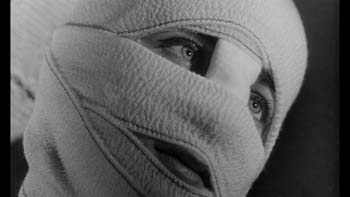
The surgery scene in Les yeux sans visage is one of the most defining moments in the film, heightened by its pseudo-scientific attention to detail (marking the area to be cut with a grease pencil, examining the medical instruments, close-ups of sweat on Dr. Génessier’s forehead, blood trickling off the scalpel as the incision is made, the lack of music to distract, etc.) and an editing pattern calculated to mount tension and apprehension over the medical process itself. Spectators in 1959 could never have expected Franju to stay with the shot of the face being pulled off (which was cut from the US export print, retitled The Horror Chamber of Dr. Faustus). It is not surprising to read accounts of audience members fainting at that point. Les yeux sans visage was released at around the same time as two other seminal modern horror films, Peeping Tom (1960) and Psycho (1960). Yet while the latter two kept any explicit violence off-screen, Les yeux sans visage stayed true to the French tradition of grand guignol by showing graphic violence.

While awaiting the proper donor Christiane (Edith Scob) wears a featureless, egg shelled mask to cover her disfigured visage (fig. 6). In Les yeux sans visage this ‘lack of a true face’ attains historical import in the way Dr. Génessier obsesses over giving his daughter back her “vrai visage” (her true face). Joan Hawkins points out that “vrai visage” “…is the term that French Nazi sympathizers used during the war to describe French racial and national purity. ‘Nous combattons le juif pour redonner à la France son vrai visage’ [We fight the Jew in order to restore to France her true face] read a 1941 sign at the Institut d’Etudes des Questions Juives (Institute for the Study of Jewish Questions).” [4]

Although the term ‘vrai visage’ is never spoken in Martyrs there is an equal obsession over reducing their victims to the point where they reveal a “pure gaze.” Anna’s ‘keeper’ reacts with rapturous joy when she sees what they perceive as ‘the martyrs’ look’ on Anna’s face. She calls Mademoiselle to tell her the great news: “I have never seen an expression like it. She’s let go, completely let go. Her face is like…..her eyes….I swear she no longer sees anything around her.” After the phone call there is a cut to an amazing close-up of Anna’s eye; the camera zooms into her pupil, to a pure white light, and then pulls back out of her dilating pupil (fig. 8). The cult’s obsession with notions of ‘purity’ and ‘essence’ may be an indirect reference –if not to “le vrai visage”– at least to issues of racial & national purity. Also relevant to the issue of racial purity is the fact that, as pointed out earlier, both Lucie and Anna are clearly non-white (Eurasian and Moroccan), while all the members of the cult are white, (and mainly old) men and women.
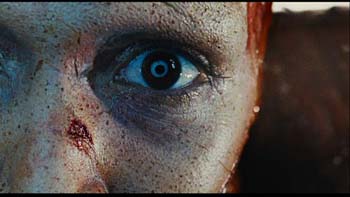
After about the 4th or 5th beating session, the torture sequence takes a surprising contemplative turn, as Anna’s pain turns ‘interior’. The music becomes melancholic, and the camera seems to caress Anna by moving in close-up hand-held around her battered body. Anna begins to think about Lucie. She caresses her own face with the back of her hand, as if her hand were not her own, but Lucie’s. The suffering is almost over and she begins to detach herself from her surroundings, taking comfort in her memory of Lucie. In a stark close-up, in which she is barely recognizable from the beatings, her thoughts turn completely to Lucie. We hear a subjective voice-over of their two voices, although it is hard to distinguish them:
Lucie: “Anna, are you there.
Anna: “I’m there?” “Yes, Lucie?”
Lucie: “Why are you never scared.
Anna: “I am scared sometimes.
Lucie: “Not like me.”
Anna: “I didn’t go through what you did.’
Anna: “How do you stop being scared?”
Lucie: “Let yourself go, I think.
Anna: “You think so?”
Lucie: “Let yourself go.”
Anna: “And if I can’t, will you be there?”
Lucie: “Yes”
Anna: (Out of the voice-over) “I miss you”
The image fades to black. Laugier succeeds in what must have seemed like an impossible task at the script level: shifting from a series of brutal scenes to this quiet, romantic interlude where the love between Lucie and Anna is consolidated and, in a strange way, Anna seems to have defeated her torturers through the power of memory and love. The scene fades back in with the same beautiful music, and the same woman enters to feed Anna, who still seems lost in her reverie. The contrast between the range of emotions Anna is experiencing and the way the woman and the man mechanically go about their activity as if it were a regular job, recalls the Nazi edict of ‘just taking orders.’ The torturers continue to work, like doctors, recalling Les Yeux sans visage and the medical experiments during the Holocaust.

The representation of the torturers in Martyrs goes against the grain of what audiences normally expect in torture films. The are shockingly unimpressive and non-threatening. Mademoiselle and her entourage of nicely dressed bourgeoisie, the handsome, middle class couple that ‘manage’ the victims for the cult, or the seemingly normal family that Lucie slaughters at the beginning of Martyrs, defy torture film character convention. The depiction of the torturers in Martyrs as mundane, ordinary looking people recalls Hannah Arendt’s notion of the ‘banality of evil’ which came out of her report on the Jerusalem trails on the war crimes of German Nazi Eichmann, Eichmann in Jerusalem: a Report on the Banality of Evil (1964). In what was seen to be a controversial reading, Arendt did not see Eichmann as a “monster of irrational evil,” but more like a calculating machine, a “…rational, pragmatic bureaucrat, a typically modern figure accepting evil commands in a banal and routine manner.” [5] This describes the villains in both Les yeux sans visage and Martyrs. Dr. Génessier maintains a chilling callousness and professionalism throughout that disguises a repressed cruelty and sadism borne out of unacknowledged guilt and perhaps his own unacknowledged failings as a doctor. The torturers in Martyrs perform with an equal sense of distanciation from their victims. The appearance of normality represented by the quaint family life at the beginning of Martyrs –a sister and brother bickering at the dinner table, with the mother and father playfully trying to instill some parental order– makes a striking contrast to the unimaginable grand guignol horror show taking place in the basement dungeon below. This echoes Dr. Génessier luxurious country estate ‘hiding’ the gruesome medical experiments he conducts in his basement laboratory; and the old-fashioned slaughterhouse on the outskirts of a modern, cosmopolitan Paris in Les sangs de bêtes.
Much of this ‘banality’ comes from the way in which, in both Les yeux sans visage and Martyrs, the torture is conducted as if it were part of an objective scientific/medical process. The name most often invoked in this context is Josef Mengele (16 March 1911 – 7 February 1979), “a German SS officer and a physician in the Nazi concentration camp Auschwitz-Birkenau….[who] gained notoriety for being one of the SS physicians who supervised the selection of arriving transports of prisoners, determining who was to be killed …and for performing human experiments on camp inmates, amongst whom Mengele was known as the Angel of Death.” [6]
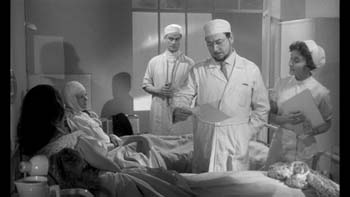
Although it would be a stretch to claim every crazed doctor committing medical experiments on humans as an allusion to Joseph Mengele, there is a scene in Les yeux sans visage which may be a sly reference to Mengele’s noted attempts to change eye color by injecting chemicals into children’s eyes. (Wikipedia) The scene in question occurs right after the ‘shorn women’ scene, and sees Dr. Génessier visit a young boy after an eye surgery to retard his oncoming blindness. Although he puts on a positive front with the boy’s mother, it is obvious from his physical examination of the boy that the operation did not succeed (the failure perhaps being an indirect reference to his own facial transplant failures, as well as Mengele’s failed experiments to change a person’s eye color).
While Dr. Genéssier, a Joseph Mengele-like doctor figure, is surrounded by German Shepard dogs, most of the cult members who are summoned to the house at the end to hear Mademoiselle’s testimony, are seen arriving in German cars (most prominently Mademoiselle in a Mercedes Benz). Mademoiselle asks Anna: “Did you see….the other world?” Mademoiselle bends over to hear Anna’s words whispered softly into her ears. The audience sees her lips move but hears nothing.
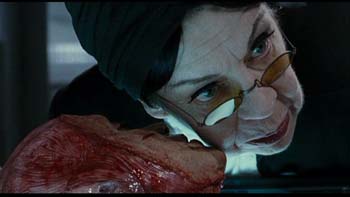
A senior member of the cult, Etienne, tells the cult members who have gathered for the grand moment, that Anna is special. Of the seventeen subjects she is only the fourth to have reached this stage, and the first to have lived through this experience long enough to tell them what she has seen. He relates the moment in a tone of scientific objectivity: “Between 12:15 and 2:30pm Miss Assaoui clearly saw what lay beyond death…her state of ecstasy lasted two hours and fifteen minutes. This was not a near-death experience. She experienced authentic martyrdom. At 2:30pm she came out of this state and at 3:05 pm she spoke. At this moment she is still alive, but she has stopped communicating. Mademoiselle heard her testimony. That testimony, my dear friends, will be shared with you in a moment.” The audience is probably as eager to hear this testimony as the cult members, but the film opts for pure enigma by having Mademoiselle keep the secret to herself. After preparing the waiting members for Mademoiselle’s great revelation, Etienne goes to tell Mademoiselle that the party is ready for her. Etienne speaks to Mademoiselle through a bathroom door, while she removes her façade (makeup, eyelashes, headscarf, etc.).
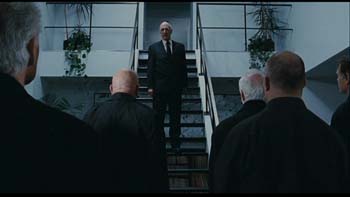
Etienne: Mademoiselle. They are all waiting.
Mademoiselle: I’m coming, Etienne.
Etienne: So there is something
Mademoiselle: Of course.
Etienne: Was it clear?
Mademoiselle: Crystal clear?
Etienne: Precise?
Mademoiselle: It admitted of no interpretations, Etienne.
Etienne: Thank you Mademoiselle.
At this point Etienne begins to walk away, only for Mademoiselle to call him back and ask him questions.
Mademoiselle: Etienne. Could you imagine what there is after death?
Etienne: Are you alright?
Mademoiselle: Could you?
Etienne: No Mademoiselle.
Mademoiselle: She pulls a gun out from her purse, puts it into her mouth and says her final words, “Keep doubting.” From outside the bathroom we hear the off-screen sound of a gunshot.
The ending has baffled many viewers, and director Laugier is clear that his intent was to keep the ending vague and open ended. What did Anna whisper to Mademoiselle? Did Anna actually see a post-life vision? Did she see anything at all? And why does Mademoiselle refrain from informing them of what Anna said? There are many possibilities.
Reading 1: There was no great vision on Anna’s part, and Mademoiselle could no longer live with the knowledge of having tortured and killed seventeen young women in ‘vain’ (Contrarily, Dr. Génessier feels no such guilt, and dies a poetic death, being torn apart by the dogs he experimented on.) This is a viable reading and one that I endorse because it would close the circle around the theme of guilt.
Reading 2: There was no great vision on Anna’s part, but Mademoiselle wanted to keep the cult alive so dies with the secret, so that the cult is bound to continue their search because they do not know for certain one way or the other. Mademoiselle becomes a ‘martyr’ to their cause.
Reading 3: Anna did ‘see’ something grand and splendorous, so beautiful that Mademoiselle could not wait to discover it, so she kills herself.
Reading 4: Anna did ‘see’ something grand and splendorous but Mademoiselle did not want to share the knowledge with anyone.
Martyrs is not the only recent French horror film to invoke France’s Nazi past. The ultra violent Frontier(s) (Xavier Gens, 2007) deals explicitly with Nazism, with overtones of France’s collaboration guilt. In the film’s opening a group of youngsters are involved in an attempted robbery amidst an urban chaos of riots against an extreme right wing government, whom they refer to as ‘Fascists’. This sets up a nice touch of irony which sees them leave for the countryside to evade the police, but land in the clutches of a family of Texas Chainsaw-styled cannibals led by a rabid neo-Nazi. They are lured to the home by two attractive women who function as the seducers. Paralleling the architectural horror of Les yeux sans visage and Martyrs, there is a human slaughterhouse in the bowels of the house (we see one of the victims hanging upside down by his ankles bled like a pig). The Nazi connection is introduced in a scene where a young woman scans a room and we see a point of view shot of Nazi regalia (photos, artifacts, etc). The surprise comes with the introduction of the group’s father-figure, Le Von Geisler (Jean-Pierre Jorris), an elderly, blondish man wearing a Nazi uniform, who speaks French in a halted German accent and talks about winning the war, about the purity of race, etc. Actor Jorris plays his character at the edge of satire. For example, to stop a prisoner from escaping Geisler cut’s the man’s ankle tendons, adding “just like they did to slaves in Africa.”
In the question and answer period after the screening of Martyrs at the 2008 Festival du nouveau cinéma, director Pascal Laugier said his intention with Martyrs was to make a film that would be transgressive even for hardcore horror fans, not simply to make a horror film for horror fans. Transgressive in the sense that the intense violence was directed at suffering and not pain and catharsis; and transgressive in the way it maintained its thematic ambiguity. Given my reading of the film –that Martyrs is also ‘about’ France’s collective National guilt over the Vichy regime and French collaboration and questions of national race and purity– then you can add ‘political’ as a factor that makes Martyrs a multi-faceted transgressive horror film.
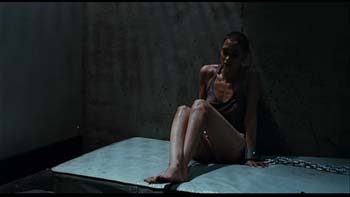
Endnotes
1 Adam Lowenstein. “History without a Face: Surrealism, Modernity, and the Holocaust in the Cinema of Georges Franju” in Shocking Representation. New York: Columbia University Press, 2005, 17-53, 188-197.
2 One of the best accounts of this is “Crime and Punishment in Liberated France: The Case of les femmes tondues,” by Claire Duchen, in When the war was over: women, war, and peace in Europe, 1940-1956, by Claire Duchen, Irene Bandhauer-Schöffmann, Published by Continuum International Publishing Group, 2000. Joan Hawkins also touches on this in the essay cited below. You can see a video on Youtube entitled “Femmes tondues à la libération en 1944” displaying archival photos of les femmes tondues.
3 The Nazis also shaved the hair of both men and women in the concentration camps and made great profit selling the hair (‘hair cloth’ as it was called) to make coats, rugs, clothing, etc. Shorn Women’s Hair.
4 Joan Hawkins. “The Scalpel’s Edge: George Franju’s Les Yeux san visage,” in Cutting Edge: Art-Horror and the Horrific Avant-Garde. Minneapolis-London: University of Minnesota Press, 2000, 65-85, 235-243, 71.
5 Bernard Crick, “Hannah Arendt,” Dictionary of Modern Culture,” ed. Justin White, London: Ark Paperbacks, 1984, p. 9.
6 Josef Mengele. Wikipedia.



